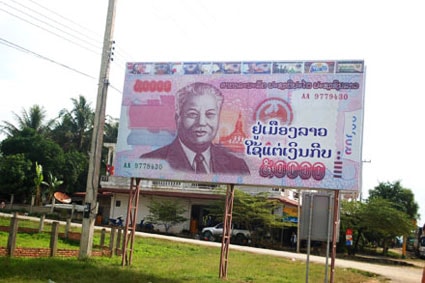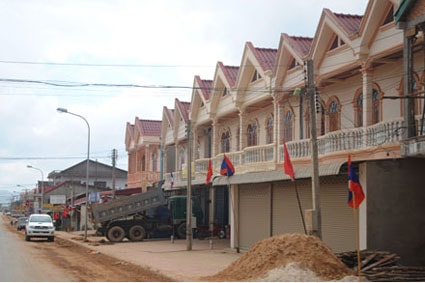Narrative of the city and the forest (part VI)
I once knew that the Lam River in my hometown originates from the Nam Khan River on the Xieng Khouang Plateau. I wonder if the Muong Kham fields are irrigated by the Nam Khan River? But the Lao village in the middle of the golden rice valley of Muong Kham is as peaceful as the midland villages along the Lam River in Vietnam...
(Baonghean) -I once knew that the Lam River in my hometown originates from the Nam Khan River on the Xieng Khouang Plateau. I wonder if the Muong Kham fields are irrigated by the Nam Khan River? But the Lao village in the middle of the golden rice valley of Muong Kham is as peaceful as the midland villages along the Lam River in Vietnam...
The rice valley in the middle of Muong Kham district is thousands of hectares wide. But looking at the way Lao farmers cultivate and the fields are densely packed with banks, they certainly have not converted their land like us. Rice growers do not seem to have to pay agricultural taxes. Many farmers have purchased multi-function plows and other mechanical agricultural tools. In the fields stretching along the national highway, the golden rice fields are endless and have a wild beauty like a famous Van-goc painting.
Passing through the rice fields is the central area of Muong Kham district. Muong Kham central market is truly a unique market. If you were in Vinh city, you would think this was a hastily built stall area to serve an exhibition fair. The market is located on a gentle hillside, wild with weeds. Looking from afar, it is a series of small stalls with pointed roofs and wooden planks. The goods are not displayed in a messy manner like the market in our country, but on the stalls, each item is clearly marked. Buying and selling is not noisy and very quick.

Billboard with Lao currency in the center of Muong Kham.
The center of Muong Kham has a more urban appearance than Noong-Het. The streets are more orderly, showing the hand of a planner. Small passenger cars come and go in and out of the station busily and a few "Tuk tuk" cars have begun to appear. The strangest thing is that next to the central stadium, a large billboard with the image of Lao currency has been erected. Later, I heard that it was to promote the honor of the kip or to fight against "dollarization"; because in Laos, besides the kip, there are many other currencies in circulation on the market: the most popular is the US dollar, then the Thai baht, the Vietnamese dong and recently, it seems, there is also the Chinese yuan...
In the afternoon, the car arrived in Phonsavan, the capital of Xieng Khouang province.
Many people in our country think that Phonsavan is the provincial capital of Xieng Khouang province. But according to Vinh, Phonsavan is the general name of a district. The center of Phonsavan is just a village with its own name, and at the same time is also the location of the headquarters of Xieng Khouang province (in Laos there is no commune level). Looking at the appearance, this center looks like a young urban area in Vietnam. Tuk tuk is a type of three-wheeled motorbike imported from Thailand, now becoming one of the popular means of transportation here. I jumped on a Tuk tuk for a souvenir trip and had to pay 6,000 kip for less than a kilometer around...

A new corner of downtown Phonsavan.
The center of Phôn-Xa-Vân seems to have only one “Hotel Xieng Khoang” as a possible accommodation facility; besides receiving foreign delegations, it mainly serves a few Western guests. Offices, post offices, and commercial centers are located in a large circle around a spacious open space like a square in a big city. Phôn-Xa-Vân has a dance floor “Hmong paradise” with spending tips no less than the dance floors in Vinh city. If not, the way of playing here is even more “Western” than in our country because you can, thanks to acquaintances and matchmakers, have beautiful Western backpacker dance partners from Europe. However, the “tips” are a bit expensive, a little extravagant can cost up to a million Vietnamese Dong. I heard that this dance floor has investment from “Mong people” in the US…
After a drinking party with friends, Vinh finished a case of wine labeled Champa flowers, Duc - a Vietnamese businessman of some stature in Xieng Khouang enthusiastically drove his private car to take us "on a tour" as he put it. But this was the occasion to prepare for the Lao People's Revolutionary Party Congress in Xieng Khouang province, lively entertainment services such as Karaoke, the red and green bar in Phonsavan were almost closed. In this regard, it can be said that you are being too strict compared to us. Thanks to Duc's diplomatic talent, when he heard that there were Vietnamese guests, also journalists, a thatched hut "specially" opened its doors to welcome guests.
Mr. Duc has a permanent residence on Nguyen Van Cu street, Vinh street, but he is already a sophisticated "artist" in this country of a million elephants...
…

After a Tuk tuk ride in the center of Phonsavan.
The clear wine labeled with Champa flowers, no matter how long you drink it, does not make you collapse, nor does it make you drunk to the point of agitation. It is a kind of drunkenness that makes you drift to a sadness with a bit of illusion. After another round of Lao beer, I heard Vinh whispering and coaxing in my ear... Then everyone disappeared somewhere unknown. I did not know what to say to the owner of the shop whose face was neither sad nor happy nor ever smiled, but whose sharp eyes always accurately grasped the customer's intentions. And for the first time, I had a glass of Lao beer with a Lao person. I vaguely remembered Keo, a Lao student studying at Thai Binh University of Medicine 20 years ago...
Keo is a nickname for them or his name, I don’t know. But I remember Keo was the most simple-minded student among the Lao students I knew at the Northern universities at that time. Keo loved Hang – my high school classmate. Keo followed Hang to my hometown, wearing shorts, flip-flops, shirtless, showing off her bronzed skin, and busily went to my garden to pick herbs to prepare for a drinking party. But Keo didn’t eat dog meat. Keo drank wine with green bananas dipped in salt and talked about his home somewhere near Long Cheng in the southwest of the Plain of Jars. Long-Cheng – a place I was familiar with through the famous work “Ky su Xieng Khoang” by writer Bui Binh Thi. Hang and Keo later got married and moved to Long-Cheng, the result of a beautiful Vietnamese-Lao love story.
Is Long Cheng far? I wonder if I can meet Keo and Hang?...
(continued)
Sam Temple






